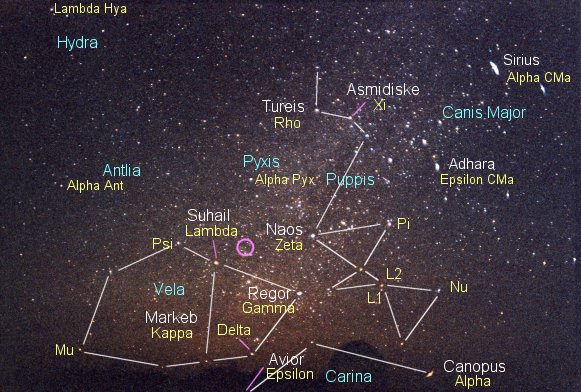 HR 3497 hosts another of the "hot Jupiters," which, with a low
measured mass, may be more of a "hot Saturn."
HR 3497 hosts another of the "hot Jupiters," which, with a low
measured mass, may be more of a "hot Saturn."
THE PLANET
The circle shows the location of the class G dwarf star HR 3497
(the faint star at dead center), found in the rich star fields of
the constellation Vela. The planet orbits
its parent star with a very short period of 3.51 days (among the
shortest known), at an average distance of 0.046 Astronomical Units
(6.9 million kilometers, 4.3 million miles), 12 percent Mercury's
distance from the Sun and just 8 times the radius of the parent
star. Only a handful of the known planets are closer. The
measured mass, which is a lower limit to the true mass, is also
very low, only 0.42 times that of Jupiter, or 1.4 times that of
Saturn. Though very close to its star, the planet still has a
small orbital eccentricity of about 5 percent. From the planet,
the star would appear to be nearly 14 degrees across, nearly three
times the separation between the front bowl stars of the Big Dipper.
|
 HR 3497 hosts another of the "hot Jupiters," which, with a low
measured mass, may be more of a "hot Saturn."
HR 3497 hosts another of the "hot Jupiters," which, with a low
measured mass, may be more of a "hot Saturn."
 HR 3497 hosts another of the "hot Jupiters," which, with a low
measured mass, may be more of a "hot Saturn."
HR 3497 hosts another of the "hot Jupiters," which, with a low
measured mass, may be more of a "hot Saturn."